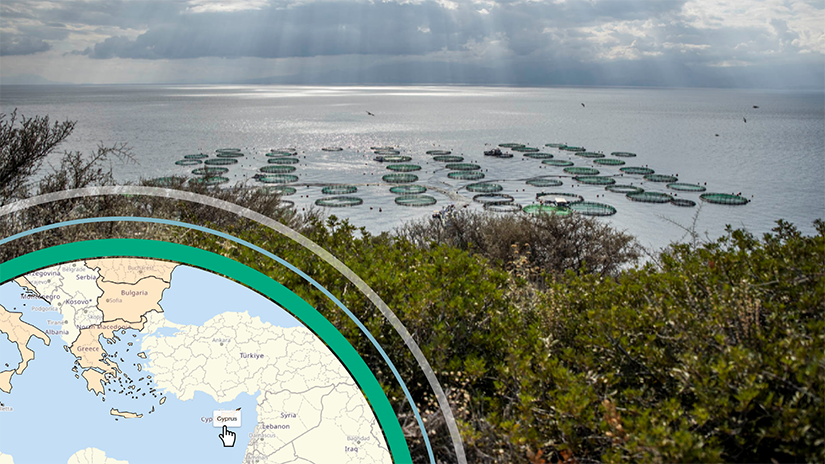Background information

Auginamų rūšių rūšis
Jūrų pagelai (Sparus aurata), paprastieji vilkešeriai(Dicentrarchus labrax), Meagre (Argyrosomus regius), Rainbow Trout (Oncorhynchus mykiss), Sturgeon (Acipenser sp.), jūrinės krevetės (P. indicus & P. vannamei)
Šaltinis: 2023 M., EUMOFA; 2022 M., ŽMTEK; 2021 m. Žuvininkystės ir jūrų mokslinių tyrimų departamentas, DFMR
Gamybos būdas
Kipre beveik visa (> 90 proc.) gamyba vykdoma jūrų vandenyse, daugiausia naudojant narvus atviroje jūroje. Gėlo vandens kultūroje ir (arba) sausumoje esančiuose įrenginiuose ūkiuose pagaminama nedaug produkcijos.
Šaltinis: 2023 M., EUMOFA; 2021 M. DFMR
Sektoriaus dydis (gamyba ir vartojimas)
Šaltinis: 2023 M., EUMOFA; 2021 M. DFMR
Tendencijos (ankstesnės ir būsimos)
- Vyriausybės politika akvakultūros sektoriuje siekiama tvarios ir ekologiškai subalansuotos akvakultūros plėtros, siekiant kuo labiau padidinti jos indėlį į vidaus žuvų gamybą, atsižvelgiant į vietos ir tarptautinių rinkų poreikius ir teikiant aukštos kokybės ir higienos produktus, atitinkančius vartotojų lūkesčius.
- Toliau skatinti, remti ir stebėti tolesnę sektoriaus plėtrą, daugiausia dėmesio skiriant atviroje jūroje vykdomai akvakultūrai. Tokia praktika užtikrina mažesnį poveikį aplinkai ir gerą jūrų aplinkos būklę.
Šaltinis: MNSPA; 2021 M. DFMR
Akvakultūros poveikis šalies ekonomikai, maisto rinkai ir darbo rinkai
- Akvakultūra Kipre sudaro apie 85 proc. visos Kipro žuvininkystės produkcijos tiek kiekybiniu, tiek vertės požiūriu, ji užtikrina apie 350 tiesioginių darbo vietų visą darbo dieną ir padeda kurti šimtus kitų pagalbinių profesijų atstovų. Akvakultūra yra neatsiejama ir labai svarbi Kipro žuvininkystės sektoriaus ir apskritai nacionalinės platesnės kaimo ekonomikos dalis. Ši veikla buvo sparčiausiai auganti pirminės maisto gamybos pramonė Kipre per pastaruosius 15 metų.
- Akvakultūros produktai yra trečias pagal svarbą pagal eksporto vertę platesniame Kipro pirminės gamybos sektoriuje po bulvių ir citrusinių vaisių, todėl labai sumažėja neigiamas Kipro prekybos žuvininkystės produktais balansas. Jūrų akvakultūra sudaro daugiau kaip 99 proc. visos nacionalinės akvakultūros produkcijos ir turi didžiausią augimo potencialą. Priešingai, gėlųjų vandenų akvakultūra ribojama dėl sumažėjusio gėlo vandens prieinamumo ir didelių veiklos sąnaudų, susijusių su vandens recirkuliacijos sistemų diegimu.
- Be to, Kipras yra vienas iš penkių ES šalių pagal akvakultūros indėlį į žuvininkystės gamybą.
Šaltinis: MNSPA; 2021 M. DFMR
Iššūkiai ir galimybės
- Atsigavimas po COVID-19 pandemijos, prisitaikymas prie kintančios pasaulinės aplinkos ir žalioji pertvarka.
- Prisidėti prie apsirūpinimo maistu saugumo Sąjungoje pasitelkiant konkurencingą ir tvarią akvakultūrą ir atitinkamas rinkas.
- Plėtoti tvarią mėlynąją ekonomiką ir skatinti pakrančių bendruomenių klestėjimą.
- Galimybės gauti ES finansavimą
- Mažesnė sugautų žuvų žvejybos apimtis.
- Naujų technologijų pritaikomumas ir naudojimas su veiksmingesnėmis akvakultūros sistemomis.
- Produktų diferencijavimas.
- Perėjimas prie tvarių maisto sistemų ir piliečių lūkesčiai kinta ir lemia didelius maisto rinkos pokyčius.
Šaltinis: MNSPA
Užimtumas ir įmonių skaičius
3 krante esančios jūrų veisyklos, 1 krevečių išaugimo ir (arba) peryklos vienetas, 9 jūriniai jūrų blokai, 8 pakrantės gėlųjų vandenų akvakultūros vienetai.
350 darbuotojų
Šaltinis: MNSPA
Multi-annual National Strategic Plans for the development of sustainable Aquaculture
Relevant Authorities
Applicable Legislation
- 2000–2010 m. Akvakultūros įstatymas
- 2002–2010 m. akvakultūros (bendrosios) taisyklės
- 2001 m. Potvarkis dėl vandens taršos kontrolės (vėžiagyvių vandens kokybė) (P.I. Nr. 9/2001)
- 2001 m. Potvarkis dėl vandens taršos kontrolės (Švaraus vandens kokybės standartai žuvų gyvybei išsaugoti) (P.I. Nr. 10/2001)
- 2001 m. Gyvūnų sveikatos įstatymas (Įstatymas Nr. 109(I)/2001)
Applicable Procedures
Akvakultūros veikla taip pat reglamentuojama atitinkamomis kitų teisės aktų, pavyzdžiui, Aplinkos apsaugos institucijos, nuostatomis, susijusiomis su aplinkos būklės ir kokybės apsauga, taip pat su Veterinarijos tarnybų, gyvūnų apsaugos ir gerovės tarnybų nuostatomis visuomenės sveikatos ir ūkiuose auginamų organizmų sveikatos ir gerovės klausimais.
- Licencija steigti ir eksploatuoti žuvų ūkį išduodama remiantis 2000–2010 m. Akvakultūros įstatymais ir atitinkamais jų pakeitimais, taip pat atitinkamomis taisyklėmis.
- Miesto planavimo ir būsto departamento planavimo leidimas.
- Aplinkos departamentas. Leidimas atlikti biudžeto įvykdymą.
- DFMR licencija steigti ir eksploatuoti žuvų ūkį.
- Veterinarijos tarnybų akvakultūros produktų gamybos veterinarijos licencija.
- Licencija steigti ir eksploatuoti žuvininkystės ūkį išduodama remiantis 2000–2010 m. Akvakultūros įstatymais ir atitinkamais jų pakeitimais, taip pat atitinkamomis taisyklėmis.
- Aplinkos apsaugos patvirtinimas, kurį suteikia Aplinkos departamentas.
- Ministrų tarybos leidimas naudoti jūrų erdvę (pasiūlymą rengia ir Tarybai pateikia Žemės ūkio, kaimo plėtros ir aplinkos ministras).
- DFMR licencija steigti ir eksploatuoti žuvų ūkį.
- Veterinarijos tarnybų akvakultūros produktų gamybos veterinarijos licencija.
National associations and networks
Kipro Marikultūrų asociacija
Contact Details
Kipro žuvininkystės ir jūrų mokslinių tyrimų departamentas
Constantinos MOUSTAKAS, Žuvininkystės ir jūrų mokslinių tyrimų pareigūnas
- Paštas
- Fakso numeris ir (arba) e. paštas: + 357 2280 7850
